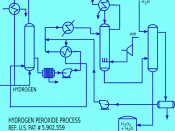Process Flow Strategies � PAGE \* MERGEFORMAT �8�
Running head: PROCESS FLOW STRATEGIES
Process Flow Strategies
Michael Stewart
FIN515 Operations Manageme
November 1, 2009
Process Flow Strategies
The optimal goal in most businesses is to have a profitable bottom line. The solution in obtaining this optimal goal is to prevent the least amount of errors and be as cost effective in doing so. Reid and Sanders addresses three process flow strategies: make-to-stock, assemble-to-order, and make-to-order that define a business's positioning strategy. These strategies, based on a business's competitive priority will determine how an operation system is organized (Reid & Sanders, 2007, p. 75).
Additionally to the process flow strategy, the internet-based application of electronic data interchange (EDI) has changed the evolution of computer-to-computer communication. According to Reid and Sanders (2007), "EDI is a form of computer-to-computer communication standardized for sharing business documents such as invoicesâ¦product stocking numbers" (p. 105). Information technology has played an increasingly significant role in maximizing supply chain efficiency and minimizing its complexity.
It's become especially critical for distributors, as trading partners on both ends of the chain have been driving and, in some cases, mandating the adoption of such technologies (Kaplan & Cioletti, 2009 p. 41-42).
Make-To-Stock Strategy
Make to stock (MTS) is a manufacturing method in which finished goods are produced and stocked prior to receipt of a customer order. "It uses a forecast based on past demand history to initiate production of end items when inventory has fallen below desired levels, instead of waiting until a final quantity and configuration is described on a customer order" (Bridgefield Group, 2006). According to Reid & Sanders, the make-to-stock strategy is to "make them ahead of time to ensure that they are always available upon demand" (p. 69). Product and service focused businesses have a tendency to...


